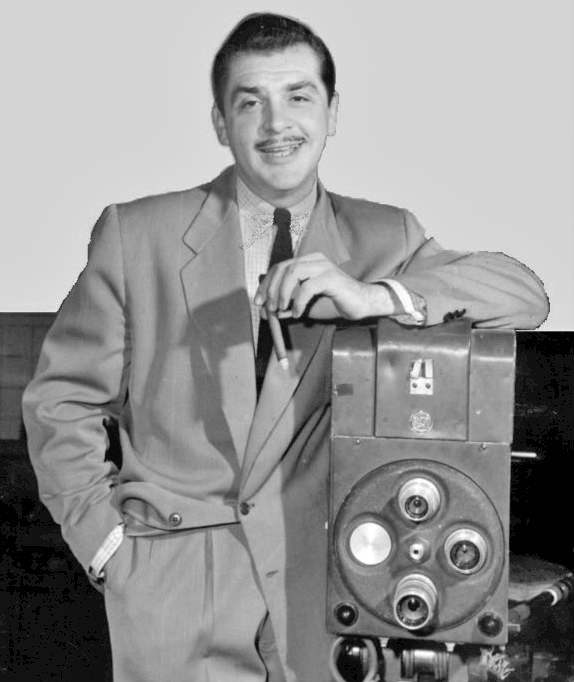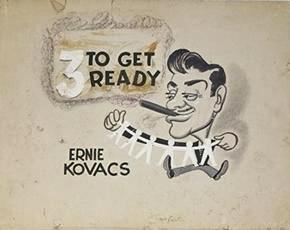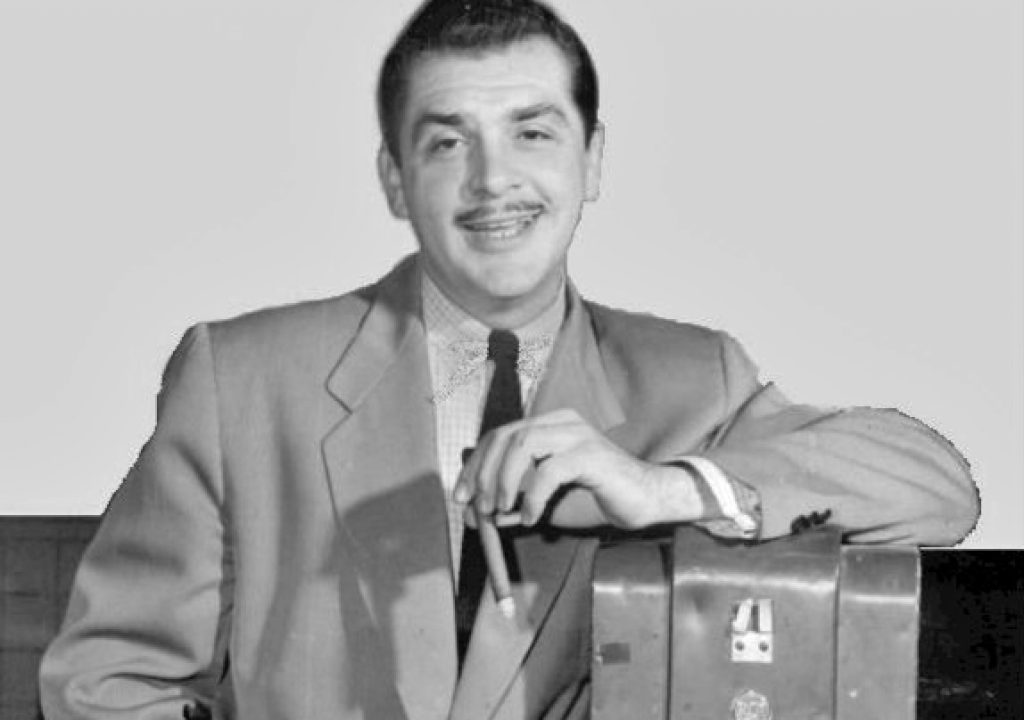If you aren’t saying to yourself “Ernie who?” then you might be saying “Why Ernie Kovacs?” These articles have been about the technical side of developments that took place in the salad days of television. Yes, Kovacs was part of early television but as a writer, producer, director and talent in front of the camera.
However, Kovacs was not content to just turn the cameras on and let the engineers adjust them so they looked as good as possible. He wanted them to do more (both the engineers and the cameras). For Ernie, television was a playground for his imagination and he was able to do anything he could dream up – whether it made sense or not. As long as it was funny. Simply put, Kovacs was an innovator who took to the new medium like a fish to water and in the process pushed television, the medium and the technology, forward as no one else had until that time.
He didn’t burst on the scene fully formed. The mustachioed, chain cigar smoker started practicing his unique brand of humor on local radio audiences in Trenton, New Jersey, in 1941. Even after being tapped for television, Ernie would successfully step back into radio with a successful morning show at WABC in New York City.

Ernie Kovacs 1956 Publicity Photo
His first opportunity to start playing with images came when he was hired by one of the first commercial television stations in the nation – WPTZ in Philadelphia, the third television station in the nation to be granted a commercial license and the first outside of New York City. WPTZ also was the first affiliate of the fledgling NBC Television Network and was one of three stations (along with WRGB in Schenectady, NY) to premiere NBC’s regular television service in 1946.
The station wanted to try a new concept – morning television. Remember, this was a time when most stations’ transmitters weren’t even powered up or, at best, were only transmitting a test pattern. The new show Ernie was to helm took to the air from 7:30am to 9:00am, the first television wake up show in the country.

TTGR, as it came to be known, began with a format not much different from the radio disk jockey shows of the time. Ernie would play records, read weather reports and adlib his way through the ninety minute show as a clock superimposed in the lower left of the frame kept viewers apprised of the time.
This was fertile ground for Ernie’s mind. Having honed his craft well in radio, Kovacs used his ability to ad lib to make the show something more. Couple this to the visual void in the program’s format and it was inevitable he would start to explore what could be done with pictures and sound. Kovacs first began to draw cartoons during the records or would ad lib to props thrown to him by crew members off camera. Before long, “the program blossomed into full blown (and sometimes dangerous) daffiness, all completely improvised,” as Diana Rico describes in her book “Kovacsland.”
Kovacs also began playing with the visual element that would make it more compelling than a radio show with pictures. One short example Rico uses is reproduced in a “script” from one of the shows:
“Stage manager sets up ladder… Ernie climbs up and disappears [out of frame]… Stage manager returns, folds up ladder and takes it away… Camera pans to desk where Ernie is seated.”
For the first two weeks of the show there were no sponsors – just an experiment to see if anyone would watch. Andy Mckay, Kovacs’ stage manager for TTGR said in an interview with the Philadelphia Inquirer in 1987, “Then, it gradually began to get popular. By September of 1951, we had so many sponsors that the show went from ninety minutes to two hours.”
McKay was also the primary prop thrower, too. When he could tell his boss was searching for something to say, he’d throw a prop in from off camera. This would jumpstart the Kovacs mind and he’d be off again onto some new adlib.
Eventually, TTGR would be cancelled so WPTZ could accommodate NBC’s own new early morning vehicle, “The Today Show.”
Kovacs loved playing with the camera frame. In his book “The Ernie Kovacs Phile,” David G. Wally states “Some sight gags really confused the home audience. With a pane of glass between himself and the camera, Kovacs proceeded to paint out the entire picture until there was only black. He also used the glass to lob eggs and custard pies at the audience just to make sure they were paying attention.”
Remember, this was a time before special effect generators. The only thing a video switcher could do was cut or dissolve between video sources or black. Any other trick had to be invented mechanically or optically. The television matte amplifier didn’t come on the scene until CBS engineers invented it around 1953. The crew had to use ingenuity, light and a lot of black velour to make some of Ernie’s effects work with the equipment they had on hand.
On those older video switchers, the fader bars could be split in order to create a superimposed image on top of the background scene. It was being done mostly to add credits to a show at the end. However, Ernie wanted to manipulate his actors to be large or small, headless or bodiless, standing on his cigar, peer through a hole in their head, etc. The crew would dive right in to accommodate him.
x
It was accepted that Ernie respected his crews even as he worked them to death. Later on, after videotape arrived, he would take hours and hours to get a shot just right. But his crews were right there at his side attempting to carry out his crazy ideas. For this was a time in television when there were still no rules and “Let’s try it and see what happens” rather than “That’s impossible” was the initial reaction when Kovacs would bring his engineers some idea from out of his head. It also didn’t hurt they would often all end up making triple overtime as they worked around the clock.
Carl Weger was a cameraman and lighting director at WPTZ during the Kovacs period. Early television cameras required flat light levels “slightly less than the noon day sun,” as he told Diana Rico in her book. The newer Orthicon cameras were more sensitive so Weger began experimenting with turning off some of the banks of lights and using spotlights and lighting from angles. Weger was one of the first to provide more modeling and three dimensional looks to the sets and performers. When Kovacs started playing with camera tricks, it sparked Weger’s inventiveness to come up with ways to accomplish them.
One trick in particular is often cited and attributed to Weger. What the audience saw was Ernie standing on the ceiling of a room vacuuming it. Everyone was hard pressed to figure out how it had been done. Even the engineers at NBC in New York called to ask how they had accomplished it. Weger did it by mounting two mirrors at forty five degree angles in a soup can then mounting the can on a three inch camera lens. It could even be rotated for additional effects.
Another trick Kovacs worked out with his crew was to put a can of sterno just below the lens. The heat of the flame would make the air shimmer which is all the audience would see and he would dissolve between two shots that way. Of course, today, any computer with a video editing program can do the same thing. But in 1950, an effect like that was groundbreaking.
Kovacs did split screens before RCA built the first special effects generator. He would put cardboard cut to block one side of the lens on a camera. Then block the other side of the lens on another camera. Then by manipulating the bars on the video switcher, both cameras would be on the air.
One of his more artistic concepts was to attach a kaleidoscope to a camera lens and rotate it in time with a music track.
This was all done live in the days before videotape. Because there was an interconnection with New York, executives at NBC were watching some of the Kovacs craziness. They knew there was great talent there but they weren’t sure what to do with it.
While he was still doing the local TTGR morning show, NBC came up with “Time for Ernie,” an afternoon show to try Ernie out on a national audience. It would run Monday through Friday from 3:15 to 3:30 (fifteen minute shows were common in early television), would originate from the same studios where he was doing the morning show and would use the same crew. It was just Ernie, no other actors. Only a trio of musicians would be on hand to break up the skits with musical interludes or provide musical accompaniment or punctuation to Ernie’s antics. The show did not last long (May 14th to June 29th, 1951).
But it served its purpose. NBC was pleased enough to give him a summer replacement slot for “Kukla, Fran and Ollie,” a puppet show popular among both adults and children, just as Ernie’s local morning show was. “Ernie in Kovacsland” went on in the 7:00 to 7:30 evening time slot, Monday through Friday beginning on July 2nd, 1951.
With a prime time network placement came a bigger budget. Kovacs was able to add more talent. An actor and a girl singer (a staple of television variety shows of the time) were hired. The girl singer was Edie Adams and would later become Kovacs’ second wife.
But the show was still Ernie’s and even though he had been assigned writers, he still did the show his way even in spite of some initial network interference to show who was in charge. Ernie kept on doing what he did best – throwing out the script, adlibbing, inventing camera tricks and making people laugh.
As time passed, Kovacs did more live shows but never had the huge hit he was searching for. And he never was able to get the networks or the critics to completely understand him. He did receive recognition for his summer replacement show on NBC in 1956. The short series received four primetime Emmy nominations in 1957.
And there was single thirty minute special he did for NBC in 1957. It was another “Ernie Kovacs Show” but has become better known as the “The Silent Show.” The show was done entirely without dialogue – only camera tricks, sound effects and music. It sparked an outpouring of critical acclaim. John Crosby of the New York Herald Tribune called one of the sketches, “reasoned nonsense much like that of “Alice in Wonderland.”
Even though he never had a big hit or a show that lasted longer than a couple years, his influence can be seen in television shows and talent that came later. It is commonly reported that David Letterman, Rowan and Martin’s “Laugh-In” and “Saturday Night Live” bore Kovacs’ fingerprints. He was even said to have even been an influence to the Monty Python group.
Kovacs’ manic early shows never were sent outside the USA so the Python association was questioned until an article titled “Ernie Kovacs: An American Secret” written by Frank Bren appeared in the Bright Lights Film Journal in 2011. In it, the author quotes Python member Terry Gilliam, “The Ernie Kovacs Show knocked me sideways into a world where the bizarre and the daft and the preposterous all lived happily alongside wisdom, wit and perception. I had never experienced anything so visually absurd and inventive.”
Eventually, Kovacs moved to Hollywood and was featured as a scripted character in several movies. He wanted to produce and direct for the big screen but wasn’t able to attain that level of control over a feature film project.
Tragically, Ernie Kovacs’ life was cut short when an automobile accident took his life in 1962, just a few days shy of his 43rd birthday. At the time, he was doing a series of specials for the ABC network. They were done on videotape and still survive today, unlike much of his early work that, having been done live, is now lost forever.
Like a grand master who’s work is not highly successful in life but then is studied, praised and even revered after their death, history now looks at Kovacs as the first person to bring forth programs that were invented for television that couldn’t have been done on the stage, radio or in motion pictures.
Just like the world of art, Ernie Kovacs has been labeled. Critics have called him a surrealist, post-modern or avant-garde. Terms usually reserved for artists whose work is on canvas or in marble. Not someone who was known for manipulating electrons and glowing phosphors.


